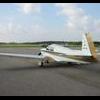Thanks for the suggestion. I will add the mixture check to the squawk list for annual this winter. We have gone over the baffling and cowl flaps with the local mechanic and at Joey Coles a couple of years ago when he did a new top, but that is worth another look too I suspect.
I am useing a JPI EDM-800. It does read a bit higher than the factory guage on #3 where there are two probes. It is #4 that usually wants to get too hot though. If all I had was the factory guage I wouldn't even know about it.
I have always thought it was interesting that in Bob Kromer's test flight article from 2000 he had near red line CHT for a some of his climb. This sort of led me to think it was the nature of the beast in some respects. I assume he was just using the stock guage on #3. Makes me wonder what the other three cylinders were doing.
Bob's test data:
Continuous Climb Data 1966 M20C N3411X Full throttle, 2700 rpm, mixture leaned to 100-125 degrees rich of peak, cowl flaps open, airspeed as noted
Elapsed Time
Altitude
MIAS
MP
RPM
Oil Temp
CHT
OAT
Rate of climb*
Climb#1 Airspeed at Constant 100MIAS
0:00
1000'
100
27.8
2700
200
400
97
---
1:02
2000'
100
26.9
2700
200
440
92
968
2:40
3000'
100
25.9
2700
205
440
89
612
3:57
4000'
100
24.9
2700
205
430
84
779
5:08
5000'
100
23.9
2700
205
415
81
845
6:30
6000'
100
23.0
2700
200
415
79
732
8:04
7000'
100
22.1
2700
200
420
73
638
9:47
8000'
100
21.2
2700
200
415
69
582
11:37
9000'
100
20.4
2700
200
415
64
545
13:42
10,000'
100
20.0
2700
200
415
59
521
Elapsed Time
Altitude
MIAS
MP
RPM
Oil Temp
CHT
OAT
Rate of climb*
Climb#2 Airspeed at Constant 120MIAS
0:00
1000'
120
27.8
2700
205
410
98
---
1:00
1800'
120
27.0
2700
205
425
96
800
2:00
2550'
120
26.2
2700
205
430
92
750
3:00
3480'
120
25.2
2700
205
425
88
930
4:00
4080'
120
24.7
2700
205
425
82
600
5:00
4860'
120
24.1
2700
205
425
79
780
6:00
5570'
120
23.2
2700
205
420
74
710
7:00
6250'
120
22.9
2700
205
415
72
680
8:00
6680'
120
22.4
2700
205
410
70
630
10:00
8680'
120
21.7
2700
205
405
65
500
12:00
8950'
120
21.9
2700
205
405
60
270
14:00
9320'
120
20.1
2700
200
405
56
335
15:46
10,000'
120
19.7
2700
200
405
54
385
* Under perfect flight test conditions, rate of climb should decrease smoothly as altitude increases. However, the air was very turbulent on our day of the test, so that is the reason why the numbers don't decrease evenly. Nevertheless, this test was a good one for 'real world' conditions and is pretty representative of what a C model will do on a hot day.


